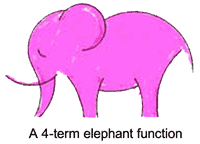Catalytic Kinetics and Elephant Curves
In studying the kinetics of surface-catalysed reactions, the usual procedure is to propose a reaction mechanism based on the Langmuir-Hinshelwood-Hougen-Watson model, derive its corresponding equation, and then fit it to the data at hand. If the fit is good, the researchers then claim that they have hit on the actual mechanism of reaction.
Spoilsports suggest that this procedure simply represents a curve-fitting exercise, and tha t before one can claim to have discovered the reaction mechanism, one must reject all other plausable mechanisms. Just finding a mechanism to fit the data is not good enough.
t before one can claim to have discovered the reaction mechanism, one must reject all other plausable mechanisms. Just finding a mechanism to fit the data is not good enough.
In addition, with three to eight adjustible parameters that appear in these models, it is not surprising that one can fit the equation to a set of kinetic data. To add weight to their objections, these spoilsports like to quote the statement attributed to the great German mathematician, Friedrich Gauss, which when translated into English goes something like
Give me four parameters, and I will draw an elephant for you; with five I will have him raise and lower his trunk and his tail.
Wei challenged this assertion (1) and proceeded to draw the best elephant he could with various number of parameters. Here I show his results with 5, 10, 20 and 30 adjustable parameters.
Not very elephanty elephants, even with 30 parameters.
 But to say that it cannot be done -that Gauss was not a great enough mathematician to be able to draw an elephant with 4 parameters -is most unlikely. Reference (2) shows that this is a simple matter.
But to say that it cannot be done -that Gauss was not a great enough mathematician to be able to draw an elephant with 4 parameters -is most unlikely. Reference (2) shows that this is a simple matter.
There may be other reasons for not attributing this often quoted statement on elephants to the great Gauss, however, not being able to draw an elephant given a mathematical form and four parameters to be set by the fitter should not be one of them. So beware, all you LHHW disciples.
Professor R. Krishna of the University of Amsterdam (3) shows how to have the elephant raise and lower his trunk and his tail.
References
1. J. Wei, Chemtech,1975, May, 128-128-IBC
2. 0. Levenspiel, Chemical Innovation, 2000, March, IBC
3. www.science.uva.nl/research/cr/elephant_tail/

